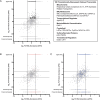Widespread release of translational repression across Plasmodium's host-to-vector transmission event
- PMID: 39777415
- PMCID: PMC11750109
- DOI: 10.1371/journal.ppat.1012823
Widespread release of translational repression across Plasmodium's host-to-vector transmission event
Abstract
Malaria parasites must respond quickly to environmental changes, including during their transmission between mammalian and mosquito hosts. Therefore, female gametocytes proactively produce and translationally repress mRNAs that encode essential proteins that the zygote requires to establish a new infection. While the release of translational repression of individual mRNAs has been documented, the details of the global release of translational repression have not. Moreover, changes in the spatial arrangement and composition of the DOZI/CITH/ALBA complex that contribute to translational control are also not known. Therefore, we have conducted the first quantitative, comparative transcriptomics and DIA-MS proteomics of Plasmodium parasites across the host-to-vector transmission event to document the global release of translational repression. Using female gametocytes and zygotes of P. yoelii, we found that ~200 transcripts are released for translation soon after fertilization, including those encoding essential functions. Moreover, we identified that many transcripts remain repressed beyond this point. TurboID-based proximity proteomics of the DOZI/CITH/ALBA regulatory complex revealed substantial spatial and/or compositional changes across this transmission event, which are consistent with recent, paradigm-shifting models of translational control. Together, these data provide a model for the essential translational control mechanisms that promote Plasmodium's efficient transmission from mammalian host to mosquito vector.
Copyright: © 2025 Rios et al. This is an open access article distributed under the terms of the Creative Commons Attribution License, which permits unrestricted use, distribution, and reproduction in any medium, provided the original author and source are credited.
Conflict of interest statement
The authors have declared that no competing interests exist.
Figures






Update of
-
Global Release of Translational Repression Across Plasmodium's Host-to-Vector Transmission Event.bioRxiv [Preprint]. 2024 Mar 16:2024.02.01.577866. doi: 10.1101/2024.02.01.577866. bioRxiv. 2024. Update in: PLoS Pathog. 2025 Jan 08;21(1):e1012823. doi: 10.1371/journal.ppat.1012823. PMID: 38352447 Free PMC article. Updated. Preprint.
Similar articles
-
Global Release of Translational Repression Across Plasmodium's Host-to-Vector Transmission Event.bioRxiv [Preprint]. 2024 Mar 16:2024.02.01.577866. doi: 10.1101/2024.02.01.577866. bioRxiv. 2024. Update in: PLoS Pathog. 2025 Jan 08;21(1):e1012823. doi: 10.1371/journal.ppat.1012823. PMID: 38352447 Free PMC article. Updated. Preprint.
-
Transcriptomics and proteomics reveal two waves of translational repression during the maturation of malaria parasite sporozoites.Nat Commun. 2019 Oct 31;10(1):4964. doi: 10.1038/s41467-019-12936-6. Nat Commun. 2019. PMID: 31673027 Free PMC article.
-
Translational repression of the cpw-wpc gene family in the malaria parasite Plasmodium.Parasitol Int. 2016 Oct;65(5 Pt A):463-71. doi: 10.1016/j.parint.2016.06.007. Epub 2016 Jun 14. Parasitol Int. 2016. PMID: 27312996
-
Translational regulation during stage transitions in malaria parasites.Ann N Y Acad Sci. 2015 Apr;1342(1):1-9. doi: 10.1111/nyas.12573. Epub 2014 Nov 11. Ann N Y Acad Sci. 2015. PMID: 25387887 Free PMC article. Review.
-
Can Plasmodium's tricks for enhancing its transmission be turned against the parasite? New hopes for vector control.Pathog Glob Health. 2019 Dec;113(8):325-335. doi: 10.1080/20477724.2019.1703398. Epub 2020 Jan 7. Pathog Glob Health. 2019. PMID: 31910740 Free PMC article. Review.
Cited by
-
A 3D culture model facilitates mass production of in vitro Plasmodium falciparum haemolymph-like sporozoites.Malar J. 2025 Jul 10;24(1):224. doi: 10.1186/s12936-025-05471-x. Malar J. 2025. PMID: 40640876 Free PMC article.
-
Long lived liver-resident memory T cells of biased specificities for abundant sporozoite antigens drive malaria protection by radiation-attenuated sporozoite vaccination.PLoS Pathog. 2025 May 27;21(5):e1012731. doi: 10.1371/journal.ppat.1012731. eCollection 2025 May. PLoS Pathog. 2025. PMID: 40424562 Free PMC article.
References
MeSH terms
Substances
Grants and funding
LinkOut - more resources
Full Text Sources
Medical
Miscellaneous

